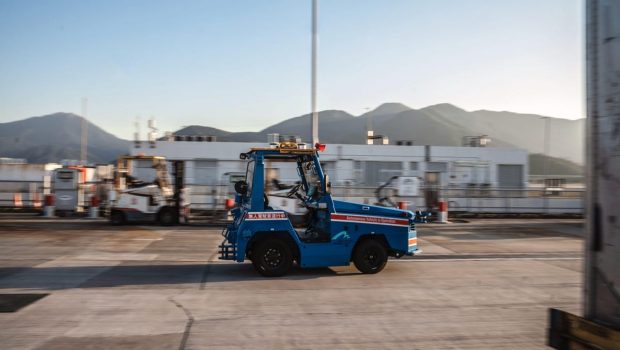A Rust Belt Bull Market, Fueled By Technology
Don’t look now, but some industrial segments are hitting new highs after tech stocks collapsed. Technology, automation, and investment are conspiring to fuel a renaissance in industrial markets. Expect this to be a big theme going forward: efficiency and growth through industrial automation.
Cutting-edge technology holds promise to boost profits and growth when applied to long-established industrial areas. Examples include autonomous driving for vehicles, automated machinery, and retail logistics using technologies such as drones. All of these have the potential to not only make industries more efficient, but also to create new value-added services.
Wall Street has tuned into this activity. Traditional large-cap tech firms such as Microsoft and Amazon have taken a hit, but Caterpillar shares this week hit an all-time high and John Deere stock is not far behind. Big industrial companies are being propelled in part by large infrastructure investments, but optimism about their transformation into technology companies is also part of the picture. This could be a trend during the next decade.
An autonomous tractor travels on the tarmac at Hong Kong International Airport in Hong Kong, China, ... [+]
Caterpillar, Deere Double Down on Automation
I wasn’t able to attend the recent CES show in Las Vegas, but industrial automation was a major theme. Agricultural and industrial machinery giants John Deere and Caterpillar took center stage.
The John Deere booth featured a gigantic Deere 412R sprayer vehicle with a 120-foot boom. The machine has 36 cameras and See & Spray Ultimate technology tapping into Deere’s massive weeds database, powered by NVIDIA GPUs. Tractors are now smart enough to pinpoint specific weeds.
Deere already produces fully automated tractors chock full of satellite navigation, data analytics, and automated driving technology. It hopes to grow huge new businesses in data and navigation technology services.
Caterpillar has its own array of high-tech mega dump trucks, some with remote piloting capabilities. It has been tapping into new services, such as annual maintenance and operations programs as well as autonomous vehicles for mining.
Automotive Looks for Software Boost
Another industry looking for a shot in the arm is the automotive industry. Traditionally a cyclical industry, the automobile business has the potential to transform itself by selling value-added services such as navigation and autonomous driving with annual recurring revenue. Automakers could also tap into new markets such as autonomous taxis.
Brad Rosen, COO and cofounder of autonomous driving technology company NODAR, said there is excitement about the potential for new growth derived from autonomous technologies. Some of the examples he gives: construction cranes, last-mile delivery, and autonomous driving.
“There are a lot of markets that will benefit from automation,” said Rosen in a video interview. “There is a lot of automation coming to construction, air taxis, trains, heavy machinery, and last-mile delivery. Air taxis are further out but that's an exciting one."
While some of the expectations for full autonomous driving have been scaled back, Rosen said that even incremental autonomous driving, such as Level 3 (L3) automation, have great potential. "L3, which is ‘eyes off,’ will create new monetization opportunities for automakers. There are going to be a quarter of a billion cars with L3 on it."
Bloomberg’s BNEF has bought into it. The research unit estimates that the market for advanced driver-assistance systems (ADAS) could grow to a $220 billion-a-year market globally by 2030.
Rosen says that full autonomous driving has great potential in markets such as robo-taxis and trucking. Autonomous trucking is expected to arrive in parts of the United States by 2026. This is compelling because of the ROI - 60% of the cost to run a truck is the driver cost, and there’s currently a driver shortage.
Robots Boost Profits, Pose Labor Challenges
As technologies such as cloud-powered artificial intelligence (AI), edge data analytics, and automation infiltrate many different industries, we are likely to see surging technology efficiencies and new opportunities in many categories. According to a recent McKinsey study, automated systems will account for 25 percent of capital spending over the next five years. The industries affected include logistics, retail, life sciences and healthcare, automotive, and food and beverage, says McKinsey.
There is wide precedent for this. Technology progress is pervasive and can improve any industry. For example, the railroad industry has been almost completely remade by automation and technology improvement – to the chagrin of labor unions. A recent New York Times article pointed out that the major railways based in the United States and Canada — which include CSX — had combined net income of $27 billion, up from $15 billion a decade earlier.
Of course, sometimes automation has a cost. Railroad labor unions aren’t happy about this. But technology efficiency is inevitable, and it’s incumbent upon our society to find ways to create new jobs, which we usually do. Humans are creative.
What will the labor unions think? My grandfather and great uncle worked in a steel mill in Pittsburgh, so I’m sympathetic. Those jobs are mostly gone. But I’m not sure there is a way to stop technological process. The best hope is for retraining on new systems or for new industries, as the labor force is consistently being reshaped.
This injection of automation can have many benefits for the industry and its customers. The businesses become more profitable and efficient, while the customers get a better product.








Gloss